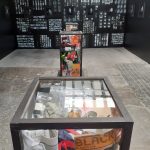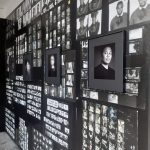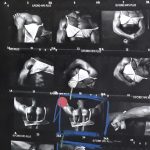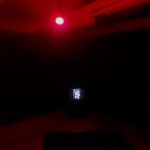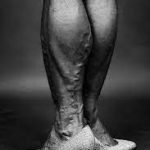London calling | chapter 2
Ajamu X
AJAMU: ARCHIVE (Autograph)
Archival Sensoria (Cubitt Gallery)
ITA (English below)
Autograph celebra gli oltre trent’anni di carriera del fotografo Ajamu X, distribuendo le ultime cento copie di AJAMU: ARCHIVE, una edizione speciale che contiene ritratti inediti e non del fotografo e attivista LGBT+. Tale pubblicazione prosegue il discorso intrapreso dall’artista durante la sua personale alla Cubitt Gallery della scorsa estate: la celebrazione del corpo maschile, del desiderio e del piacere sessuale; ma anche, un’interpretazione originale degli archivi fotografici.
AJAMU: ARCHIVE, curato e pubblicato dall’artista stesso grazie ad una campagna online di crowdfunding, è un libro d’artista firmato con una tiratura limitata di cinquecento copie, le cui ultime cento sono ora distribuite da Autograph, la galleria situata nel dinamico quartiere di Shoreditch, Londra. La collaborazione tra Ajamu e la galleria, fondata nel 1988, tra gli altri, dal fotografo nigeriano Rotimi Fani-Kayode, non è per niente casuale: fin dalla sua apertura, Autograph è stato uno dei più importanti spazi per artisti LBGT+ di colore, avendo tra i suoi scopi proprio quello di promuovere fotografi interessati ad esplorare tematiche riguardanti razza, identità, diritti umani e giustizia sociale.
Nelle intenzioni di Ajamu X, la pubblicazione di AJAMU: ARCHIVE, mira, tra l’altro, ad amplificare una problematica che oggigiorno è tutt’altro che superata, e cioè l’assenza di artisti LGBT+ di colore nel panorama artistico britannico (e, si potrebbe aggiungere, internazionale).
Il libro raccoglie 80 immagini, tutte stampate in bicromia, tra cui alcuni lavori che celebrano il corpo maschile di colore, il desiderio e il piacere sessuale che risalgono agli inizi della sua carriera, quali Heels (1993), e alla sua ricerca corrente, come Power Drill Heels (2021).
Ajamu mira ad attribuire ai propri lavori significati che vanno oltre le mere argomentazioni di rappresentazione e identità. La sua fotografia esplora, come dichiara lo stesso artista: “what I want to do and what I want to have done to my Black body” (cosa voglio fare e cosa voglio che sia fatto al mio corpo Nero).
In questa esplorazione del corpo e della sessualità, gli oggetti acquistano una posizione più che rilevante: è tramite l’uso degli oggetti che Ajamu, a volte quasi umoristicamente, investiga concetti di mascolinità e libido, trasportando sulle composizioni le sue fantasie sessuali ed esperienze. Da qui, è giustamente possibile inquadrare le fotografie di Ajamu all’interno di un filone che comprende non solo alcuni fotografi attivi negli anni ’80, come Fani-Kayode e Lyle Ashton Harris, ma anche surrealisti come Pierre Molinier (ideatore di oggetti erotici, quali le scarpe con i tacchi-dildo), Hans Bellmer, Man Ray: come questi altri artisti, Ajamu è stimolato dall’oggetto del desiderio sessuale, dal suo uso sul/attraverso il corpo, dalle fantasie scaturite dalla reciprocità tra il corpo e l’oggetto.
La campagna di crowdfunding per la realizzazione del libro AJAMU: ARCHIVE, è partita nel 2021, in contemporanea con una personale dell’artista tenutasi alla Cubitt Gallery di Londra. Organizzata dal gruppo di curatela Languid Hands, Ajamu: Archival Sensoria, fa parte di un progetto più ampio, No Real Closure, che vedrà la realizzazione di altre mostre riguardanti artisti britannici di colore. Alla Cubitt, Ajamu ha presentato nuovi lavori assieme a una selezione di foto, ma anche oggetti, estratte dal suo archivio.
Tutte le opere sono state esposte in due stanze: nella stanza principale, si trovano una serie di ritratti inediti di personaggi chiave della comunità LGBT+ di colore, tra i quali DJ, attivisti, scrittori e artisti; alcuni dei rullini sviluppati ripresi dall’archivio di Ajamu; tre teche di vetro contenenti una collezione di oggetti, quali opuscoli, videocassette, riviste, oggetti di piacere; nella seconda stanza, allestita come una camera oscura, un televisore il quale proietta alcune foto (vecchie e non) in loop.
Oltre alla già citata celebrazione del corpo e del desiderio sessuale, Archival Sensoria è anche una celebrazione della comunità LGBT+ di colore, la quale attraverso i ritratti fotografici ribadisce la propria esistenza e visibilità: For 30 years my work has been driven by a desire to show Black Queer live as we truly are: with passion, with intimacy, with sex, with desire, with love and with community (per oltre trent’anni il mio lavoro è stato guidato dal desiderio di mostrare la vita dei Black Queer per come siamo: con passione, con intimità, con sesso, con desiderio, con amore and con collettività).
Archival Sensoria ribadisce l’importanza dell’archivio, la necessità di accrescerlo e suggerisce le svariate possibilità di accostarsi ad esso, studiarlo e presentarlo. Un esempio è la seconda stanza della mostra, dove alcuni dei suoi lavori appaiono su un televisore: la stanza ricostruisce le atmosfere della camera oscura, luogo non solo di lavoro, ma anche di piacere. Ajamu, il quale lavora esclusivamente in analogico, afferma come lo stesso processo dello sviluppo di una fotografia, possa implementare una sorta di erotismo, dato dal buio dell’ambiente, dagli odori dei prodotti chimici, dall’attesa del risultato finale.
Ajamu sottolinea come l’archivio possa andare oltre la mera esperienza visiva e coinvolgere gli altri sensi, come l’olfatto e/o il tatto. Questa necessità di andare oltre l’esperienza visiva ha delle ripercussioni nella comprensione della fotografia stessa, in quanto spinge a guardare il soggetto non come corpo sociale ma come corpo materiale: in questo modo, la visione/comprensione del corpo/soggetto non avviene in termini di rappresentazione, ma di sensazioni. Del resto, come afferma l’artista stesso, “Skin is porous” (la pelle è porosa): il corpo non è solo immagine, ma materia in grado di lasciare le proprie tracce.
* * *
ENG
Autograph celebrates Ajamu X’s over thirty year career, distributing the last hundred copies of AJAMU: ARCHIVE, a special edition that contains published and unpublished portraits of the photographer and LGBT + activist. Such a publication continues the discourse undertaken by the artist during his last summer solo show at Cubitt Gallery: the celebration of the male body, the desire and the sexual pleasure; but also, an original interpretation of the photographic archives.
AJAMU: ARCHIVE, edited and published by the artist himself thanks to an online crowdfunding campaign, is an artist’s book signed with a limited edition of five hundred copies, whose last hundreds are now distributed by Autograph, the art gallery located in Shoreditch, London. The collaboration between Ajamu and the gallery, founded in 1988, among the others, by the Nigerian photographer Rotimi Fani-Kayode, is by no means accidental: since its opening, Autograph has been one of the most important spaces for LBGT + artists of colour, having among its aims precisely that of promoting photographers focusing in exploring issues concerning race, identity, human rights and social justice.
In the intentions of Ajamu X, the publication of AJAMU: ARCHIVE aims, among other things, to amplify a problem that today is far from overcome, namely the absence of LGBT + artists of colour in the British art scene (and, one might add, international).
The book collects 80 images, all printed in duotone, including some works celebrating the black male body, sexual desire and pleasure from his early career, such as Heels (1993), and his current research, such as Power Drill Heels (2021).
Ajamu aims to attribute to his works meanings that go beyond mere arguments of representation and identity. As the artist himself declares, his photography explores: “what I want to do and what I want to have done to my Black body”.
In this exploration of the body and sexuality, objects acquire a very relevant position: it is through the use of objects that Ajamu, at times almost humorously, investigates concepts of masculinity and libido, transporting his sexual fantasies and experiences to the compositions. From here, it is rightly possible to associate Ajamu’s photographs within a trend that includes not only some of the photographers active in the ‘80s, such as Fani-Kayode and Lyle Ashton Harris, but also surrealists such as Pierre Molinier (creator of erotic objects, such as the shoes with dildo-heels), Hans Bellmer, Man Ray: like these other artists, Ajamu is stimulated by the object of sexual desire, by its use on and through the body, by the fantasies arising from the reciprocity between the body and the object.
The crowdfunding campaign for the creation of the book AJAMU: ARCHIVE started in 2021, simultaneously with an artist solo show held at Cubitt Gallery in London. Organised by the Languid Hands curating group, Ajamu: Archival Sensoria, is part of a larger project, No Real Closure, which will see other exhibitions featuring British artists of colour. At Cubitt, Ajamu presented new works together with a selection of photos, but also objects, extracted from his archive.
All works were displayed in two rooms: in the main room, a series of unpublished portraits of key characters of the LGBT + community of colour, including DJs, activists, writers and artists; some of the rolls developed taken from the Ajamu archive; three glass cases containing a collection of objects, such as brochures, videotapes, magazines, objects of pleasure; in the second room, set up as a dark room, a television which projected some photos (old and not) in loop.
In addition to the aforementioned celebration of the body and sexual desire, Archival Sensoria is also a celebration of the LGBT + community of colour, which through photographic portraits reaffirms its existence and visibility: ” for 30 years my work has been driven by a desire to show Black Queer live as we truly are: with passion, with intimacy, with sex, with desire, with love and with community “.
Archival Sensoria reiterates the importance of the archive, the need to increase it and suggests the various possibilities of approaching it, studying it and presenting it. An example is the second room of the exhibition, where some of the works appear on a television: the room reconstructs the atmosphere of the dark room, a place not only for work, but also for pleasure. Ajamu, who works exclusively in analogic, states as the same process of developing a photograph can implement a sort of eroticism, given by the darkness of the environment, by the smells of chemicals, by the waiting for the final result.
Ajamu emphasizes how the archive can go beyond mere visual experience and involve the other senses, such as smell and / or touch. The necessity to go beyond the visual experience has repercussions in the understanding of photography itself, as it pushes to look at the subject not as a social body but as a material body: in this way, the vision / understanding of the body / subject does not occur in terms of representation, but of sensations. After all, as the artist himself states: “Skin is porous”; the body is not just an image, but a material capable of leaving its traces.


